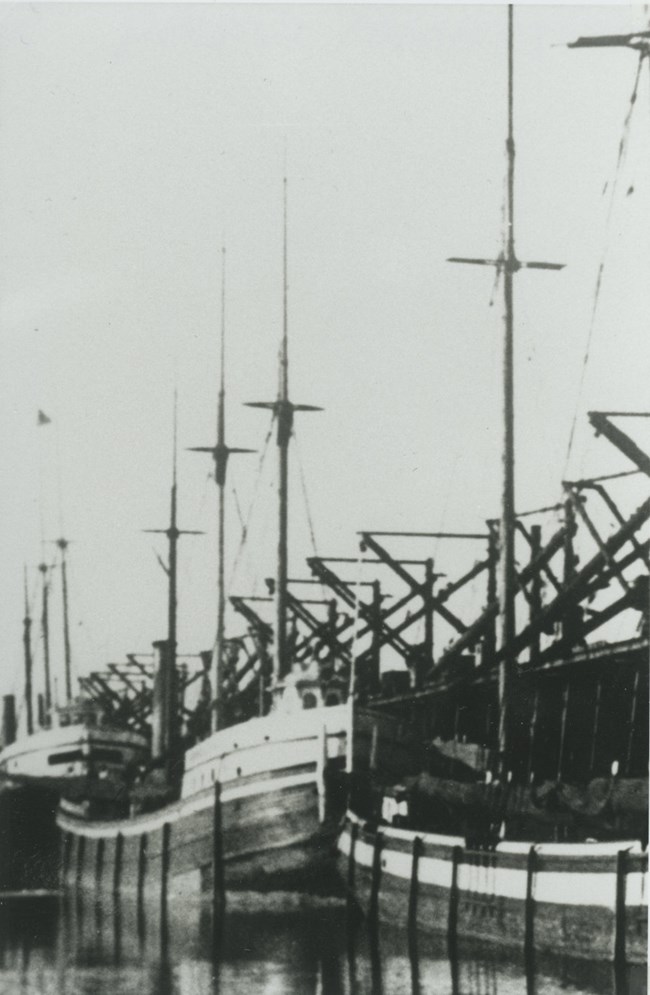Last updated: September 24, 2020
Article
SS Henry Chisholm: Construction

Great Lakes Maritime Collection, Alpena County George N. Fletcher Public Library, 31105_31137_F
Construction
Henry Chisholm was built in Cleveland by the firm Thomas Quayle's Sons, under the direction of master carpenter John Drackett (ship documents). The new bulk freighter, the largest steambarge on the Lakes, slipped down the ways August 28, 1880 (Chicago Inter Ocean, Aug. 30, 1880). The builder was an old, established firm well known for the high quality vessels they produced. The ship building company was founded by Thomas Quayle, whom some acknowledged as the father of Cleveland shipbuilders (Mansfield, 1899:1:427).
Thomas Quayle retired in 1879 (Mansfield, 1899:2:692), and upon the entry of a third son his firm became Thomas Quayle's Sons. The sons of Thomas Quayle reaffirmed the company's reputation for building large, staunch, Great Lakes vessels; when Henry Chisholm was launched it was the largest bulk freighter on the Lakes (Mansfield, 1899:1:735).
Henry Chisholm's Master Carpenter John Drackett, who was an English emigrant to Cleveland in 1851, had built many Lakes vessels. During most of his career he worked under contract for well-known Lakes shipbuilders' on both sailing craft and steamers. Drackett moved to Detroit in 1874 and in 1876 was employed for 4 years by Alva Bradley during which time he built Henry Chisholm. In 1881 he moved to Toledo and built David Dows, the only five-masted schooner on the Lakes (Mansfield, 1899:2:686). Chisholm's construction reflected the expertise of this master carpenter and was generally recognized as one of the finest steam barges on the Lakes. Captain George Stone was the superintendent of construction.
Henry Chisholm was built for Alva Bradley and launched on August, 1880. The ship received its first inspection on September 16. It was painted the Bradley colors with a green hull and red stack. The vessel originally carried three masts. Chisholm was given U.S. Registry number 95610.
Chisholm was built as a wooden bulk freighter with a single screw. These vessels were commonly termed "steam barges." It was powered by a fore-and-aft compound steam engine, which produced 1,707 horsepower, fed by twin boilers. The compound engine, built by the Globe Iron Works of Cleveland, was reportedly of the "Randolph and Elder pattern, cylinders 30x56 inches, four feet stroke" (Chicago Inter Ocean, Sept. 23, 1880). The speed of the loaded ship was about 9 knots.
Chisholm, considered a "leviathan" at the time of construction, was 270 feet of overall length and registered length of 256 5/10 feet, 39 3/10 feet in breadth and 20 3/10 feet in depth. The capacity under the tonnage deck was 1692 27/100 and the capacity of enclosures on the upper deck (poop) was 83 10/100 for a total of 1775 37/100 gross tons. Deductions allowed by the Act of August 5, 1882 totaled 443 19/100 for a total net tonnage of 1332 18/100. Permanent enrollment was dated at Cleveland, Ohio, September 18, 1880.
Chisholm was built just as shipbuilding was approaching the maximum sizes possible with wood as the principal material. Quayle's company had been experimenting with the construction of the largest of wooden hulls and their experience was incorporated into Chisholm. Iron, a recently introduced competitor, and later steel, would supersede wood for the construction of large hulls. The latter were more expensive when Chisholm was launched, which may account for the owners decision to build their hull with traditional materials. Chisholm cost $125,000.
Chisholm was a powerful towing vessel and was built with the intention of pulling one, and sometimes more, barges, as was the typical practice of the time. The barges were generally older schooners converted for towing, although some schooner barges were constructed specifically for the purpose.
